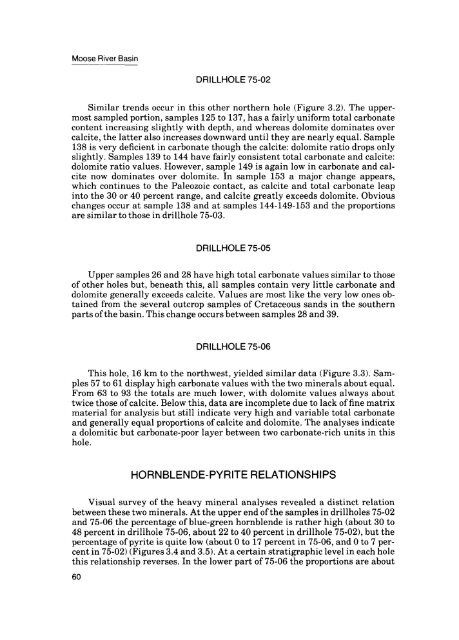Moose River Basin: geology and mineral potential - Geology Ontario
Moose River Basin: geology and mineral potential - Geology Ontario
Moose River Basin: geology and mineral potential - Geology Ontario
You also want an ePaper? Increase the reach of your titles
YUMPU automatically turns print PDFs into web optimized ePapers that Google loves.
<strong>Moose</strong> <strong>River</strong> <strong>Basin</strong><br />
DRILLHOLE 75-02<br />
Similar trends occur in this other northern hole (Figure 3.2). The upper<br />
most sampled portion, samples 125 to 137, has a fairly uniform total carbonate<br />
content increasing slightly with depth, <strong>and</strong> whereas dolomite dominates over<br />
calcite, the latter also increases downward until they are nearly equal. Sample<br />
138 is very deficient in carbonate though the calcite: dolomite ratio drops only<br />
slightly. Samples 139 to 144 have fairly consistent total carbonate <strong>and</strong> calcite:<br />
dolomite ratio values. However, sample 149 is again low in carbonate <strong>and</strong> cal<br />
cite now dominates over dolomite. In sample 153 a major change appears,<br />
which continues to the Paleozoic contact, as calcite <strong>and</strong> total carbonate leap<br />
into the 30 or 40 percent range, <strong>and</strong> calcite greatly exceeds dolomite. Obvious<br />
changes occur at sample 138 <strong>and</strong> at samples 144-149-153 <strong>and</strong> the proportions<br />
are similar to those in drillhole 75-03.<br />
DRILLHOLE 75-05<br />
Upper samples 26 <strong>and</strong> 28 have high total carbonate values similar to those<br />
of other holes but, beneath this, all samples contain very little carbonate <strong>and</strong><br />
dolomite generally exceeds calcite. Values are most like the very low ones ob<br />
tained from the several outcrop samples of Cretaceous s<strong>and</strong>s in the southern<br />
parts of the basin. This change occurs between samples 28 <strong>and</strong> 39.<br />
DRILLHOLE 75-06<br />
This hole, 16 km to the northwest, yielded similar data (Figure 3.3). Sam<br />
ples 57 to 61 display high carbonate values with the two <strong>mineral</strong>s about equal.<br />
From 63 to 93 the totals are much lower, with dolomite values always about<br />
twice those of calcite. Below this, data are incomplete due to lack of fine matrix<br />
material for analysis but still indicate very high <strong>and</strong> variable total carbonate<br />
<strong>and</strong> generally equal proportions of calcite <strong>and</strong> dolomite. The analyses indicate<br />
a dolomitic but carbonate-poor layer between two carbonate-rich units in this<br />
hole.<br />
HORNBLENDE-PYRITE RELATIONSHIPS<br />
Visual survey of the heavy <strong>mineral</strong> analyses revealed a distinct relation<br />
between these two <strong>mineral</strong>s. At the upper end of the samples in drillholes 75-02<br />
<strong>and</strong> 75-06 the percentage of blue-green hornblende is rather high (about 30 to<br />
48 percent in drillhole 75-06, about 22 to 40 percent in drillhole 75-02), but the<br />
percentage of pyrite is quite low (about O to 17 percent in 75-06, <strong>and</strong> O to 7 per<br />
cent in 75-02) (Figures 3.4 <strong>and</strong> 3.5). At a certain stratigraphic level in each hole<br />
this relationship reverses. In the lower part of 75-06 the proportions are about<br />
60

















